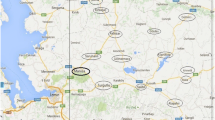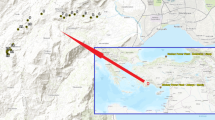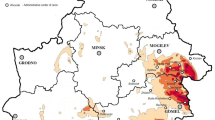Abstract
A method is proposed for performing retrospective determination of the internal irradiation dose to the thyroid gland in man as a result of 131I uptake with fresh cow milk according to the total local 137Cs fallout density resulting from nuclear explosions. It is shown that during local fallout the ratio of the numbers of 131I and 137Cs atoms on particle surfaces is about 0.46 and is independent of the fissioning material (239Pu or 238U) used in the nuclear charge. This makes it possible to determine the fallout density of 131I on soil from the local component of the total 137Cs fallout density. The information about the total 137Cs fallout density on soil is used to calculate the effect of the irradiation dose of 131I to the thyroid gland in children and adults who lived in the populated points in Altai krai during the nuclear tests conducted in the Semipalatinsk test area. The estimates agree satisfactorily with those obtained by a different method.
Similar content being viewed by others
REFERENCES
“Reconstruction of internal irradiation doses to the thyroid gland due to radioisotopes of iodine for the population living in zones of local fallout from nuclear explosions. MU 2.61.039-95,” Vestnik Nauchnoi Programmy “Semipalatinskii Poligon- Altai,” No. 4, 52–67 (1995).
“Determination of the effective external irradiation doses from local fallout from nuclear explosions from the magnitude of cesium-137 precipitation on soil,” MU 2.6.1.040-95.
O. N. Prokof'ev and O. A. Smirnov, “Retrospective determination of doses from local fallout nuclear explosions,” in: 10th International Congress of IRPA, May 14- 19, 2000, Hiroshima, Japan, p. 4b-224.
H. Beck, J. Helfer, A. Bouville, and M. Dreicer, “Estimates of fallout in the continental US from Nevada weapons testing based on gummed - film monitoring data,” Health Physics, 59, No. 5, 565–576.
Ya. N. Shoikhet, V. M. Loborev, V. I. Kiselev, et al., “Effect of radiation of the Semipalatinsk test area on Altai krai,” Vestnik Nauchnoi Programmy “Semipalatinskii Poligon- Altai,” No. 1, 7–25 (1996).
S. L. Simon, “An analysis of vegetation interception data pertaining to close-in weapons test fallout,” Health Physics, 59, No. 5, 619–626 (1990).
K. I. Gordeev, A. N. Lebedev, and M. N. Savkin, “Method for retrospective reconstruction of the parameters of the radiation conditions determining the internal irradiation of the population on the track of a nuclear explosion,” Vestnik Nauchnoi Programmy “Semipalatinskii Poligon- Altai,” No. 1, 57–96 (1994).
Handbook of Parameter Values for the Prediction of Radionuclide Transfer in Temperate Environments, Technical Report Series No. 364, IAEA, Vienna (1994).
“Probable internal irradiation doses to the thyroid gland for population in Altai krai irradiated due to a nuclear explosion conducted on the Semipalatinsk test area on August 7, 1962,” Vestnik Nauchnoi Programmy “Semipalatinskii Poligon- Altai,” No. 4, 68–69 (1995).
“Generalized derived limits for radioisotopes of strontium, ruthenium, iodine, cesium, plutonium, americium, and curium,” NRPB, 7, No. 1, 5 (1996).
Ts. I. Bobovnikova, Ya. I. Gaziev, L. E. Nazarov, et al., “Determination of the radioactive contamination on the territory of Altai krai due to nuclear weapons tests conducted on the Semipalatinsk test area,” in: Nuclear Tests, the Environment, and Public Health in Altai Krai, Barnaul (1993), Vol. 1, Part 1, p. 29.
V. M. Gavshin, F. V. Sukhorukov, I. N. Malikova, et al., “Distribution of radionuclides on the territory of Altai krai,” ibid., p. 49.
S. G. Bastron, A. I. Goncharov, A. V. Kaigorodov, et al., “Cesium-137 store in soil,” ibid., pp. 76–78.
O. N. Prokof'ev, V. A. Kolotvin, V. I. Kovalenko, et al., “Radiation-hygienic conditions in Altai krai due to strontium-90 and cesium-137 fallout,” ibid., p. 95.
Yu. V. Gudoshnikov, V. I. D'yachenko, and A. I. Mityunin, “Calculation of gamma-radiation doses on the radioactive track from cesium-137 in strontium-90 fallout,” ibid., p. 133.
V. A. Logachev, Yu. S. Stepanov, N. G. Darenskaya, et al., “Estimate of radiation conditions on the territory of Altai krai and its effect on the health of the population in Altai krai,” ibid., p. 72.
Author information
Authors and Affiliations
Rights and permissions
About this article
Cite this article
Prokof'ev, O.N. Retrospective Determination of the Internal Irradiation Dose Due to 131I to the Thyroid Gland According to the 137Cs Local Fallout Density. Atomic Energy 93, 601–605 (2002). https://doi.org/10.1023/A:1020896801366
Issue Date:
DOI: https://doi.org/10.1023/A:1020896801366




